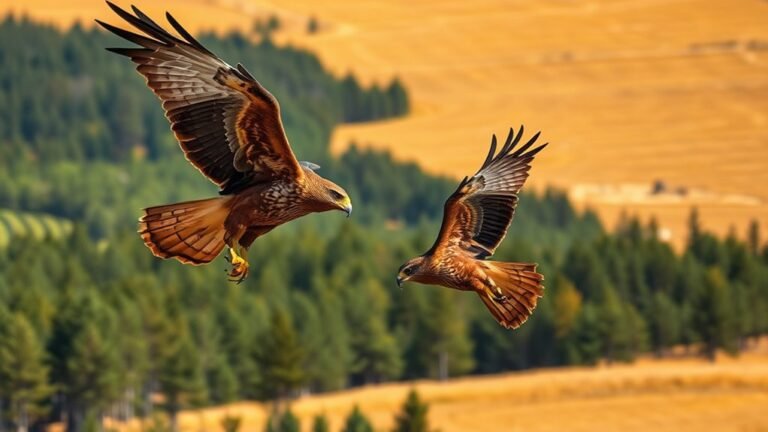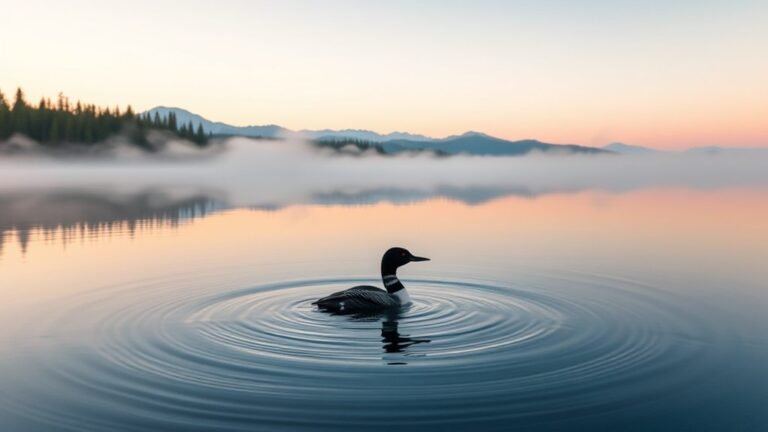Exploring Blue Birds: Types and Characteristics
When you look at blue birds, you're seeing more than just their pretty colors. You learn about their behaviors and where they like to live.
For example, the Eastern Bluebird has special places where it likes to build its nest. This shows us how it fits into nature. The Blue Jay is another blue bird. It's very smart and can adapt to many different situations.
Each blue bird has its own unique traits. These traits help us understand how they live in their environment, how they find food, and how they get along with other animals. Learning about them raises interesting questions about how they survive in the wild.
A Quick Overview
Exploring Blue Birds: Types and Features
- Eastern Bluebirds are friendly birds. They like open places and make nests in holes. During mating season, they show off their bright feathers to attract partners.
- Blue Jays are bold and smart. They have bright colors and are very social. They often make loud calls to talk to each other.
- Indigo Buntings are small songbirds. They are known for their bright blue looks. They sing to mark their territory and attract mates, especially during migration.
- Blue Grosbeaks show a difference between males and females. Male Blue Grosbeaks have bright blue feathers. They sing to attract females during the mating season.
- Tree Swallows have shiny blue-green backs and white bellies. They are social birds that live near water. They catch insects while flying.
These blue birds are not only beautiful but also play important roles in nature!
The Majestic Eastern Bluebird

The Eastern Bluebird is a bright and colorful bird that many people love to watch.
These small birds like open fields, farms, and the edges of forests for their homes. They enjoy places where there are some trees around.
When you watch Eastern Bluebirds, you can see that they're friendly and social. They often sit on high branches to look for food, mainly insects on the ground. Their sweet songs make them even more enjoyable to see and hear.
Eastern Bluebirds also make their nests in holes, often using old woodpecker holes or man-made birdhouses.
During the mating season, male bluebirds show off their bright feathers to attract females. The bright colors help them find a mate, which is very important for their breeding.
Learning about where they live and how they behave helps us appreciate these beautiful birds even more.
The Striking Blue Jay

The Striking Blue Jay
Many people know bluebirds for their bright colors, but the blue jay is special with its bold look and interesting habits.
These birds live in different places like woods, parks, and neighborhoods, so you might see them around where you live.
Blue jay behavior is really cool.
They're smart and have strong social groups. You might see them tricking other birds to get their food or hiding snacks for later.
Their loud calls help them warn others and stay close to their friends.
The Elegant Indigo Bunting

The indigo bunting is a small songbird that has a special charm. It lives in open fields and areas with shrubs. You can find them where there are a few trees and thick bushes.
In the morning, male indigo buntings sing to mark their territory and attract females. Their bright blue feathers stand out against the green surroundings, creating a beautiful sight.
When it's time for migration, indigo buntings show their ability to adapt. They may change their route based on what's happening in the environment.
Learning about where they live and how they act can help you appreciate these lovely birds even more. It also helps you feel connected to nature.
The Vibrant Blue Grosbeak
The Blue Grosbeak is a small bird that's about six inches long. Its bright blue feathers stand out and catch the eye. You can mostly find it in shrubby areas across North America.
Male and female blue grosbeaks look a bit different, which showcases their sexual dimorphism.
During mating season, male blue grosbeaks sing and show off their colorful feathers to attract females. They often sit on perches to display their beauty.
Learning about the blue grosbeak helps you appreciate birds and feel more connected to nature.
The Charming Tree Swallow
The Charming Tree Swallow is a beautiful bird. It's about 5.5 to 7 inches long. This bird has a shiny blue-green back and a bright white belly. You can find tree swallows near open spaces by water. They're fun to watch as they fly through the air to catch insects.
- Nesting: Tree swallows like to build their nests in holes. They often use old buildings or birdhouses made by people.
- Social Behavior: These birds are very social. They like to gather in groups when they migrate or look for food.
- Eating Habits: Tree swallows are great at catching insects while flying. They show off their cool flying skills as they do this.
Learning about tree swallows helps you appreciate how special they are. They're a true treasure among birds!
Frequently Asked Questions
What Habitats Are Preferred by Different Blue Bird Species?
Blue birds like to live in different places. They enjoy open woodlands, grassy fields, and even city areas. Each type of blue bird has its own favorite spot. Knowing where they like to live helps us take care of them better. By understanding their homes, we can work on keeping them safe and happy.
How Can I Attract Blue Birds to My Garden?
To attract bluebirds, put up blue birdhouses in sunny spots in your garden. Make sure they are easy to see and access. Place feeders nearby that contain mealworms, which bluebirds love to eat.
It's important to place the feeders where bluebirds can feel safe. This way, they won't get scared away by too much activity around them. Having a steady food supply will help keep bluebirds coming back to your yard. Just remember, the more comfortable they feel, the more likely they are to stick around!
What Do Blue Birds Eat?
Blue birds eat a mix of insects, fruits, and seeds. They love finding tasty bugs and snacking on berries or seeds. If you want to attract more blue birds to your garden, you can plant some of their favorite foods. Providing fruits and seeds will make your yard a welcoming place for these colorful birds. Enjoy watching them as they feast!
Do Blue Birds Migrate? if So, When and Where?
Yes, blue birds do migrate. They usually travel south when fall arrives. During this time, they move to warmer places where food is easier to find. This helps them during the cold months. In spring, they return to their original homes to breed and raise their young. It's all about finding the best conditions to survive and thrive each season.
How Long Do Blue Birds Typically Live?
Bluebirds usually live for six to ten years. Their life span can change based on where they live and how much food they can find. Healthy habitats and good food help them survive longer. Understanding how these things affect bluebirds helps us see how strong they are and how important their homes are.

Luna is the passionate founder and author of Birds and You, a website dedicated to sharing her love for birds with fellow enthusiasts. Through her engaging articles and guides, she aims to educate and inspire others to explore the fascinating world of birds. When she’s not writing, you can find Luna observing birds in their natural habitats or sharing beautiful bird photography on Pinterest. Join her on this journey to celebrate and protect our feathered friends!







